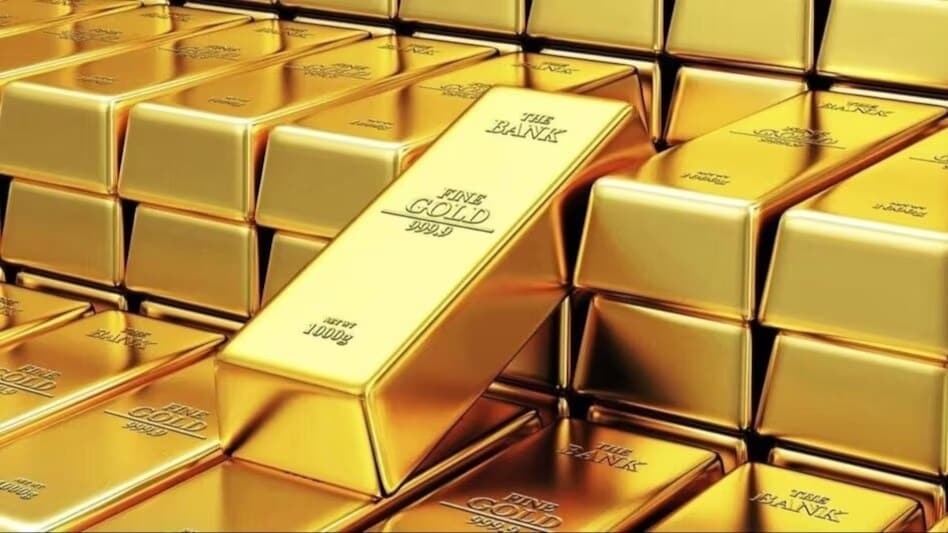 Gold's performance in recent years highlighted its 18 per cent price appreciation in 2025, while the Nifty LargeMid 250 saw a 6 per cent decline.
Gold's performance in recent years highlighted its 18 per cent price appreciation in 2025, while the Nifty LargeMid 250 saw a 6 per cent decline. Gold's performance in recent years highlighted its 18 per cent price appreciation in 2025, while the Nifty LargeMid 250 saw a 6 per cent decline.
Gold's performance in recent years highlighted its 18 per cent price appreciation in 2025, while the Nifty LargeMid 250 saw a 6 per cent decline.Gold prices surged to an unprecedented high of $3,243 an ounce due to the weakening dollar and escalating geopolitical risks stemming from the US-China tariff war. The spot gold price rose on Friday before slightly decreasing to $3,230 an ounce. In India, the 24-carat gold price closed at ₹90,161 per 10 grams, while 22-carat gold for jewellery finished at Rs 89,800. The World Gold Council noted that investor demand for haven assets like gold has increased amidst equity market declines and concerns over market liquidity during ongoing quantitative tightening.
The escalation in the US-China tariff conflict, with increased tariffs on both sides, has heightened fears of disruption in global trade, significantly affecting investor behaviour. Sean Hoey, Managing Director of IBV International Vaults London, highlighted, "As the volatility of US tariff policies continues to wreak havoc on international markets, we are seeing a significant rise in investor demand for safe-haven assets such as gold."
Jateen Trivedi, VP Research Analyst at LKP Securities, mentioned that the reciprocal tariff actions have injected fresh uncertainty into global trade flows, prompting increased hedge positions in haven assets like gold. Gold's traditional role as a hedge against currency market volatility has been reinforced by these developments, especially since the metal often moves inversely to the US dollar.
Central banks worldwide have been robustly purchasing gold, driven by macroeconomic and political uncertainties, despite elevated prices. The World Gold Council's annual survey indicates that many central banks plan to add to their gold reserves within the year. This trend has contributed to global gold demand reaching a record high in 2024, with central banks speeding up their buying in the year's final quarter.
Here's how you can invest in gold
Investing in gold remains a popular choice for those seeking to diversify their portfolios or hedge against economic uncertainties.
One of the primary methods of investing in gold is through the spot market, which caters mainly to large buyers and institutional investors. This market operates based on real-time supply and demand dynamics, with London emerging as a pivotal hub due to the London Bullion Market Association's influential role in setting trading standards and facilitating over-the-counter trades among banks and financial institutions. Other prominent gold trading centres include China, India, the Middle East, and the United States.
The futures market offers another viable channel for gold investment, allowing investors to buy or sell gold at predetermined prices for future delivery. The Commodity Exchange Inc (COMEX), a segment of the New York Mercantile Exchange, stands as the largest in terms of trading volumes, providing extensive opportunities for futures trading. In Asia, the Shanghai Futures Exchange and the Tokyo Commodity Exchange (TOCOM) also play significant roles. These exchanges provide a platform for speculating on gold prices, offering potential gains during volatile market conditions.
Exchange-traded products, notably exchange-traded funds (ETFs), present a convenient alternative for those hesitant about taking physical delivery of gold. These funds issue securities backed by physical gold, enabling investors to gain exposure to gold prices. According to the World Gold Council, physically backed gold ETFs saw a net inflow of $3.4 billion in 2024, marking the first inflow in four years, despite a slight drop in holdings. This indicates a growing investor confidence in ETFs as a strategic investment vehicle for gold.
For individual investors preferring tangible assets, purchasing gold bars and coins remains a straightforward option. Metals traders offer these in physical stores or online platforms. Gold bars and coins are not only effective as investments but also as a hedge against currency market volatility, as gold traditionally moves inversely to the US dollar. This inverse relationship makes gold an attractive option when the dollar weakens, rendering it more affordable for investors holding other currencies.